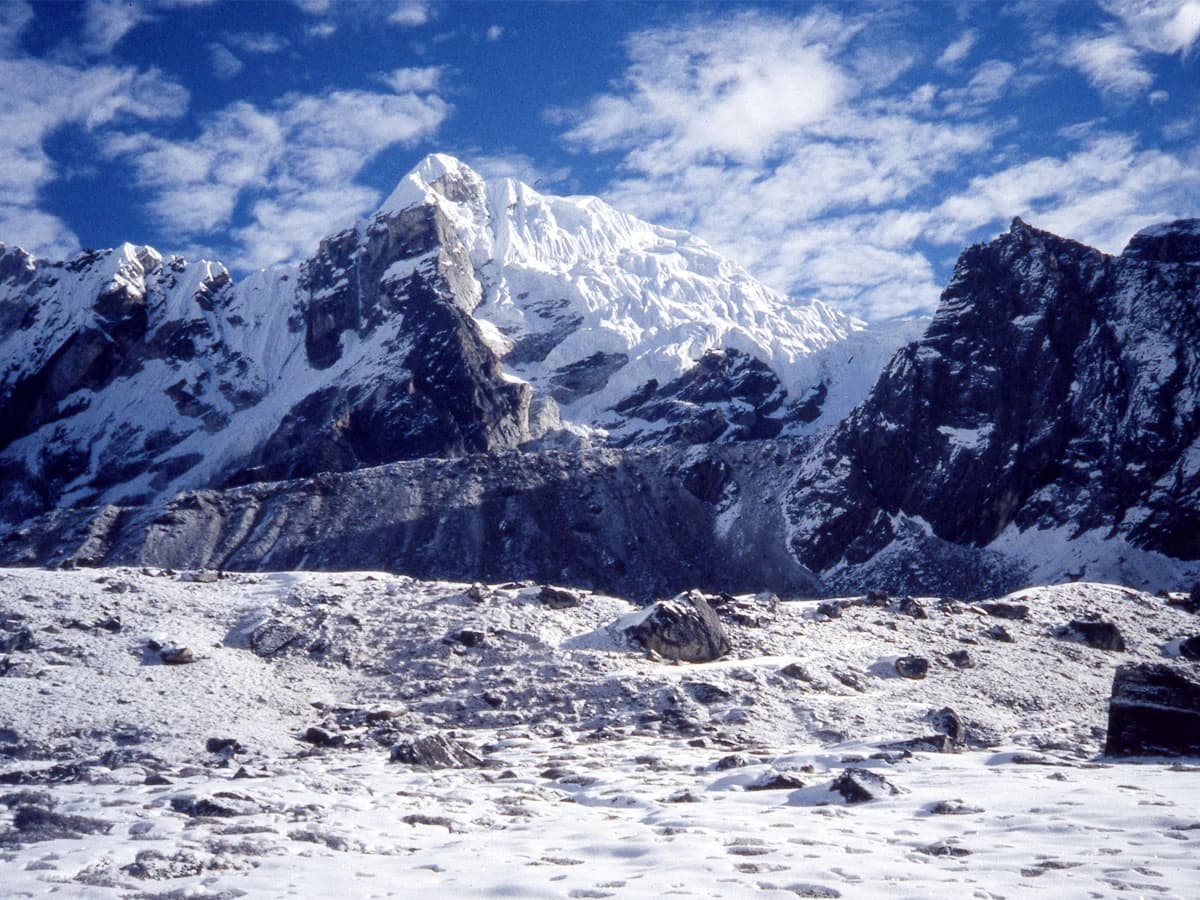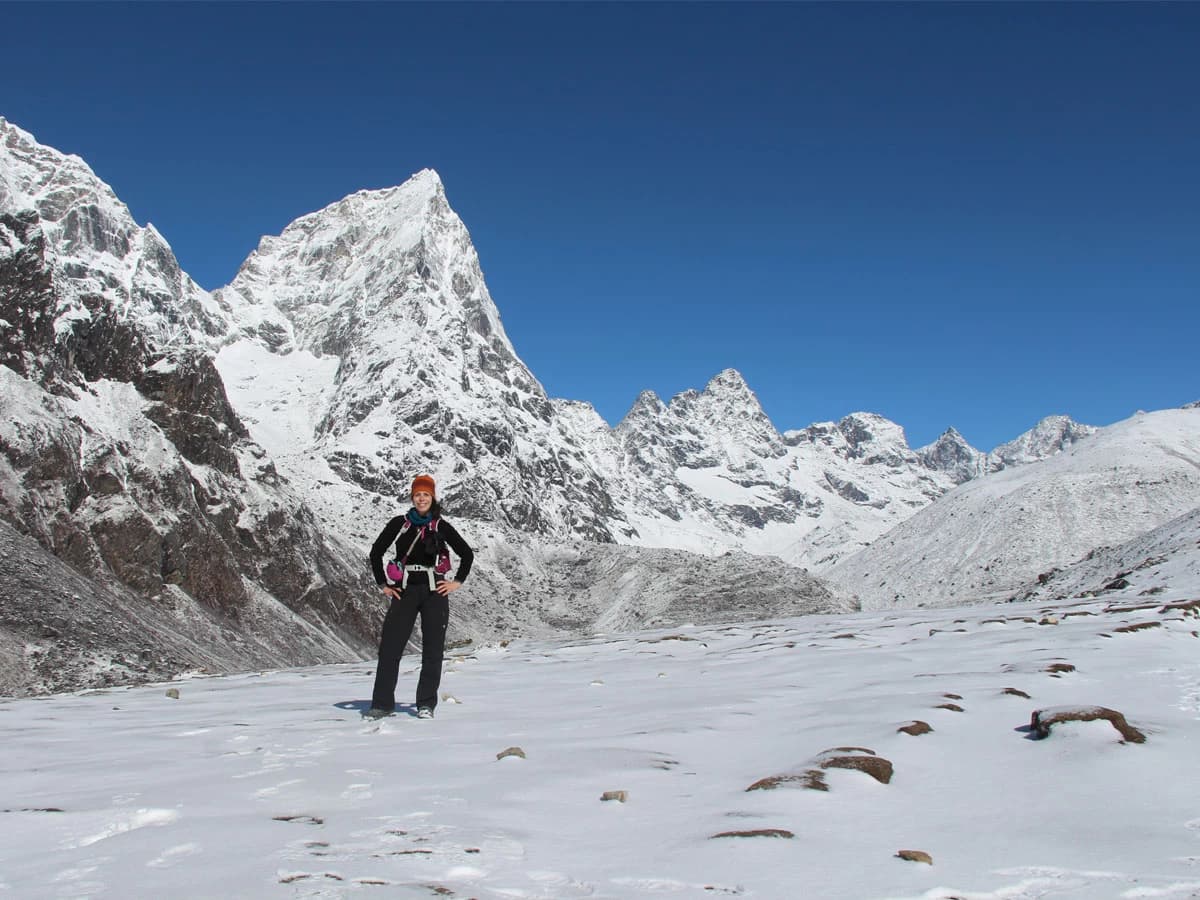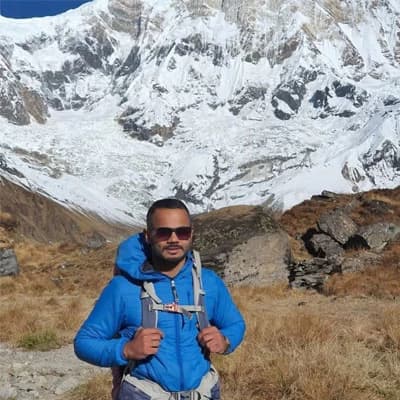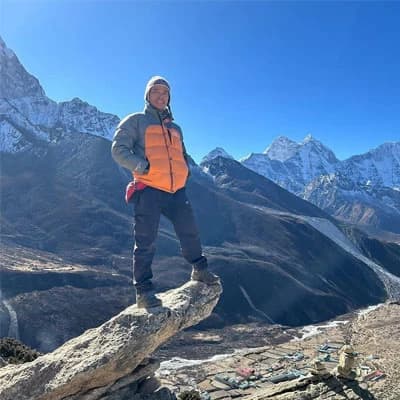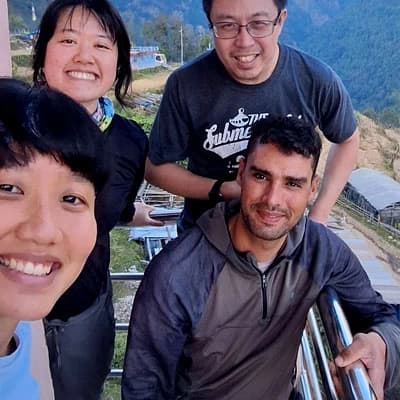Lobuche East Peak Climbing (6,119m/20,075ft) is a thrilling mountaineering adventure in the Khumbu region, challenging climbers with its steep ice slopes, exposed ridges, and technical ascents, making it one of the most rewarding trekking peaks in Nepal. This climb offers breathtaking views of Everest, Lhotse, Nuptse, and Ama Dablam while taking you through the legendary trails of the Khumbu Valley. Along the journey, you will experience the rich Sherpa culture, acclimatize at iconic locations like Lobuche and Gorak Shep, and push your limits on a final summit push that requires fixed ropes and ice-climbing skills. Reaching the summit of Lobuche Peak is a moment of pure triumph, offering an exclusive vantage point to witness the Khumbu Glacier sprawling beneath the world’s highest peaks.
Lobuche East Peak Climbing
Lobuche East Climb with Everest Trek is an exhilarating yet challenging adventure in the heart of the Everest region, offering an ideal blend of high-altitude trekking and technical mountaineering.
Standing at 6,119 meters (20,075 ft), Lobuche East Peak climbing is one of Nepal’s most sought-after trekking peaks, requiring climbers to navigate glaciers, steep ice slopes, and fixed rope sections to reach its breathtaking summit.
The journey begins with a thrilling flight to Lukla, followed by a multi-day trek through the legendary trails of the Khumbu Valley. Along the way, you will explore traditional Sherpa villages like Namche Bazaar, Tengboche, and Dingboche, acclimatizing gradually to the increasing altitude. The trek takes you past the stunning Sagarmatha National Park, home to rare wildlife such as Himalayan Tahr, musk deer, and the elusive snow leopard.
Before the summit attempt, the itinerary includes iconic highlights such as Everest Base Camp (5,364 meters | 17,598 ft) and Kala Patthar (5,644 meters | 18,519 ft), providing unparalleled views of Everest, Lhotse, Nuptse, and Ama Dablam. This pre-climb acclimatization helps prepare your body for the demanding push to the summit.
The actual climb begins at Lobuche High Camp (5,400m |17,716 feet), where climbers train with ice axes, fixed ropes, and harnesses under the guidance of expert Sherpa climbers. The summit push is a technical ascent, involving steep 45-50 degree ice slopes, requiring fixed rope navigation and careful footwork.
Reaching the summit is a moment of pure triumph, with uninterrupted panoramic views of Everest, Pumori, Lhotse, Makalu, and the Khumbu Glacier, stretching as far as the eye can see.
What sets Lobuche Peak apart from other trekking peaks is its technical nature, making it an excellent training ground for climbers preparing for higher peaks like Ama Dablam and Everest. Unlike Island Peak, which has a straightforward ascent, or Mera Peak, which is non-technical but physically demanding, Lobuche provides a true mountaineering experience.
After a successful climb, the descent follows the scenic route through Pangboche, Namche Bazaar, and finally back to Lukla, allowing time to reflect on your incredible achievement.
Highlights
- The journey begins with a thrilling flight to Lukla, offering one of the most exciting and scenic air journeys into the gateway of the Everest region.
- Trek through iconic Sherpa villages like Namche Bazaar, Dingboche, and Pangboche, gaining a unique insight into the local culture and way of life.
- Acclimatize at Everest Base Camp and soak in stunning views of the world’s highest mountain while preparing for the climb ahead.
- Climb Lobuche Peak at 6,119 meters, requiring fixed ropes and ice-climbing skills for a true mountaineering challenge.
- Enjoy breathtaking 360-degree panoramic views from the summit, including Everest, Lhotse, Nuptse, Ama Dablam, Pumori, and other towering peaks.
- Witness an unforgettable sunrise from Kala Patthar, one of the best vantage points to see the sun rise over Everest and the surrounding peaks.
- Gain valuable mountaineering experience at Lobuche High Camp (5,400 meters), preparing for the summit push with essential technical climbing skills.
- Hike through the spectacular landscapes of the Khumbu Valley, with glaciers, moraines, and towering peaks creating an awe-inspiring backdrop.
- Explore historic monasteries like Tengboche and Pangboche, witnessing the deep spiritual traditions of the region.
- Visit Sagarmatha National Park, a UNESCO World Heritage Site, where you can explore the rich biodiversity against the majestic Himalayan backdrop.
Lobuche East Peak Climbing Itinerary
Upon arrival at Tribhuvan International Airport in Kathmandu, a representative from your trekking company will warmly welcome you and assist with your transfer to the hotel.
Once you've settled in, you can take some time to unwind and soak in the city's energetic ambiance. If you arrive early, you may explore Thamel, a bustling tourist hub filled with vibrant shops, trekking gear stores, and charming cafés.
After enjoying a refreshing breakfast, attend a comprehensive trip briefing where your guide will share important details about the journey ahead. You'll gain insights into the trekking route, expected weather, essential gear, and safety protocols.
This session is also a great chance to ask any questions and ensure you're fully prepared for the adventure.
Following the briefing, you can spend the rest of the day exploring Kathmandu’s cultural landmarks, such as Swayambhunath (Monkey Temple) or Kathmandu Durbar Square, or simply unwind at your hotel before the trek begins.
The day starts with an early breakfast before heading to Tribhuvan International Airport (or Ramechhap Airport, depending on the season) for your flight to Lukla. This 30–40-minute journey is a thrilling experience, offering stunning aerial views of the snow-capped Himalayas, including glimpses of Mount Everest and other towering peaks.
Upon landing at Lukla’s Tenzing-Hillary Airport—renowned as one of the world’s most exciting airstrips—you will meet your porters and finalize preparations for the trek. After a brief orientation, the trek begins with a gradual descent along a well-paved trail that follows the Dudh Koshi River.
After trekking for 3–4 hours, you will reach the peaceful village of Phakding, nestled along the banks of the Dudh Koshi River. Here, you will settle into a cozy tea house for your first night in the mountains, enjoying a warm meal and the serene Himalayan atmosphere.
After breakfast in Phakding, the journey continues toward Namche Bazaar, the bustling heart of the Khumbu region. The trail winds along the Dudh Koshi River, offering scenic views as you pass through lush forests of pine, rhododendron, and magnolia.
The trek features a mix of gentle ascents and descents, leading through charming villages like Monjo and Jorsale. At Monjo, you will officially enter Sagarmatha National Park, a UNESCO World Heritage Site celebrated for its rich biodiversity and cultural significance.
The final stretch to Namche Bazaar is a steep uphill climb, demanding effort but rewarding trekkers with breathtaking panoramic views. On a clear day, you may even catch your first glimpses of Mount Everest and Lhotse, making the climb all the more worthwhile.
Today is an essential acclimatization day, allowing your body to adapt to the increasing altitude before trekking to higher elevations. While rest is important, engaging in light hikes is recommended to aid the acclimatization process.
After breakfast, you can take an optional hike to the Everest View Hotel (3,962m), one of the highest luxury hotels in the world, where you can enjoy breathtaking mountain views over a warm drink. Another option is a trek to Syangboche Airstrip, offering panoramic vistas, followed by a descent to Khumjung (3,790m) to visit the Khumjung Monastery, home to a legendary Yeti scalp.
In the afternoon, explore Namche Bazaar, a lively Sherpa town filled with bustling markets, charming cafes, bakeries, and trekking shops. You may also visit the Sherpa Museum to learn about the region’s rich culture and mountaineering history or simply relax at a teahouse, taking in the stunning mountain scenery.
After breakfast, the trek to Tengboche begins along a scenic and relatively easy trail, offering breathtaking views of Everest, Lhotse, Ama Dablam, and Thamserku. The path winds through lush pine and rhododendron forests, passing charming Sherpa villages adorned with colorful prayer flags, adding a spiritual essence to the journey.
After a gradual descent to Phungi Thenga (3,250m), a small settlement by the Dudh Koshi River, the trail becomes a steep uphill climb through dense forests. Though challenging, this section rewards trekkers with increasingly spectacular mountain vistas as Tengboche comes into view.
Upon arrival, you can visit the renowned Tengboche Monastery, observe Buddhist rituals, and take in the mesmerizing panoramic views. As the day ends, relax in the peaceful surroundings of Tengboche, where the towering peaks glow beautifully under the evening light.
The day begins with a descent through vibrant rhododendron and pine forests, crossing the Imja Khola on a suspension bridge. As you start ascending again, the scenery transforms into a more alpine setting, marked by sparse vegetation and rugged terrain.
The trail leads you through the villages of Pangboche and Shomare, where you will enjoy breathtaking views of Ama Dablam, Lhotse, and Island Peak. Pangboche stands out as the oldest Sherpa village in the region, featuring traditional stone houses and a historic monastery.
Upon arriving in Dingboche, the landscape opens up to reveal fields enclosed by stone walls, built to shield the crops from strong winds. This charming village offers peaceful views of Ama Dablam, Taboche, and nearby peaks. After settling into your tea house, you can relax, explore the surroundings, and take the time to acclimatize to the higher altitude.
Today serves as a key acclimatization day, allowing your body to adjust to the higher altitude. After a leisurely breakfast, you have the option to embark on a hike to Nangkar Tshang (5,083 m), a peak that offers sweeping views of the surrounding mountains, including Lhotse, Makalu, and Island Peak. This hike is a wonderful opportunity to further acclimatize while enjoying the magnificent scenery.
Alternatively, you may choose to explore the village of Dingboche, visit local monasteries, or simply relax in the serene atmosphere. This day of rest and light activity is designed to help prepare you for the next trek phase, ensuring a safer and more comfortable ascent into the Everest region.
Leaving the scenic village of Dingboche behind, the trail gradually ascends through windswept landscapes, offering breathtaking views of Taboche, Cholatse, and Ama Dablam. The path becomes more challenging as you make your way toward Thukla, where a steep climb awaits. This ascent, though short, is demanding due to the increasing altitude and rugged terrain.
At Thukla Pass, a solemn yet inspiring site awaits—memorials dedicated to mountaineers who lost their lives in the Himalayas. After taking a moment to pay respects and catch your breath, the trail continues with a steady ascent toward Lobuche, where the terrain becomes rockier, and the air noticeably thinner.
Upon reaching Lobuche, a small settlement nestled beneath the towering peaks, you will settle into a teahouse and rest for the night, preparing for the trek toward Everest Base Camp in the coming days.
The journey from Lobuche to Gorak Shep on the Lobuche East Climb and EBC trek is an exciting yet challenging trek through rugged terrain and glacial moraine.
The trail follows the Khumbu Glacier, offering stunning views of Nuptse, Pumori, and the surrounding peaks. As you navigate the rocky and uneven path, the high altitude intensifies the challenge, making every step more demanding.
Upon reaching Gorak Shep, the last settlement before Everest Base Camp, you'll take a short break and refuel before setting out on the final push to the base of the world’s highest mountain.
Reaching Everest Base Camp (5,364 meters | 17,598 ft) is a moment of triumph, standing at the foot of the legendary Mount Everest. Surrounded by towering peaks and the immense ice formations of the glacier, you will have time to soak in the atmosphere, capture photos, and celebrate this incredible achievement.
The journey from Gorak Shep to Kala Patthar (5,644m | 18,519ft) is one of the most rewarding yet demanding segments of the trek. You will begin the climb early in the morning, braving the cold and high-altitude winds to reach the famous viewpoint before sunrise.
After spending some time absorbing the mesmerizing views and capturing stunning photographs, you will descend back to Gorak Shep for breakfast. From there, you will retrace your steps toward Lobuche (4,940m |16,210ft), a relatively easier trek compared to the morning’s climb.
The return journey offers a chance to appreciate the rugged beauty of the Khumbu Glacier and surrounding peaks from a different perspective. Upon reaching Lobuche, you will rest and recover, reflecting on the remarkable journey to Everest’s best vantage point.
Today, you will leave Lobuche and begin your ascent toward Lobuche High Camp (5,400m | 17,716ft) in preparation for the summit push. The trail gradually climbs through rocky terrain and glacial moraines, offering spectacular views.
As you ascend, the air becomes thinner, making the trek more physically demanding. Proper pacing and hydration are essential to adjust to the increasing altitude. After several hours of trekking, you will reach High Camp, where you will settle into your tented accommodation.
Here, you will have a final pre-climb briefing, check your climbing gear, and rest before the challenging summit push ahead. A warm meal and early rest will prepare you for the exhilarating climb to Lobuche East Summit the next day.
The much-anticipated summit day begins before dawn, with an early start around midnight or 1-2 AM. Equipped with crampons, ropes, and ice axes, you will begin the steep and strenuous ascent toward the Lobuche East Summit (6,119m | 20,075ft).
The initial section consists of rocky trails, followed by icy slopes that require technical climbing skills. As you approach the summit ridge, the climb becomes more demanding, but the sight of the rising sun illuminating the Himalayas keeps you motivated.
Upon reaching the summit, you will be rewarded with panoramic views of Everest, Lhotse, Nuptse, Ama Dablam, Pumori, and Makalu. The feeling of accomplishment at standing atop one of Nepal’s most stunning trekking peaks is truly unmatched.
After spending some time at the summit, you will carefully descend back to High Camp, navigating the steep icy slopes with the assistance of your guide. Once at camp, you’ll rest, rehydrate, and celebrate your successful summit before preparing for the journey back down.
This extra day is set aside as a buffer in case of unexpected delays due to weather conditions, altitude-related issues, or other unforeseen circumstances that might affect the summit attempt. The Himalayan weather can be unpredictable, and having this reserve day increases the chances of a successful and safe ascent of Lobuche East (6,119m | 20,075ft).
If the summit attempt is postponed due to bad weather or other factors, this day allows for an additional opportunity to reach the peak. If the climb goes as planned without delays, this day can be used for rest and recovery at a lower altitude before continuing the descent.
The descent from Lobuche High Camp (5,400m/17,716ft) to Pangboche (3,930m/12,894ft) is less physically demanding than the ascent but still requires careful attention to rocky terrain and glacial moraine.
As you make your way down, enjoy stunning views of the surrounding peaks and pass through the village of Dingboche, offering more picturesque Himalayan vistas. Upon reaching Pangboche, you will be at a much lower altitude, making breathing easier and the journey more comfortable.
Take time to explore the village’s monastery before settling in for a peaceful evening to reflect on your incredible trek.
The day begins with a descent from Pangboche (3,930m/12,894ft) towards Namche Bazaar (3,440 m/9,383 ft). The trail takes you through dense forests of pine and rhododendrons, with occasional glimpses of the towering Ama Dablam and other peaks. Along the way, you will cross the Imja Khola via a suspension bridge before climbing steadily toward Namche Bazaar. As you approach Namche, the landscape transitions into a vibrant alpine environment with terraced fields and stone walls.
Upon reaching Namche, the bustling hub of the Khumbu region, you’ll be welcomed with the comfort of tea house accommodation. Namche is a great place to explore with its lively market, cafes, and panoramic views of the surrounding mountains, including Everest and Lhotse. The evening is ideal for resting and reflecting on the beautiful journey through the Khumbu region.
On the last day of your trek, you will journey back to Lukla, following the well-trodden paths of the Dudh Koshi Valley. The descent is mostly gentle, leading you through verdant forests, traditional Sherpa villages, and scenic suspension bridges that once marked the beginning of your adventure.
Upon arriving in Lukla (2,860m), you'll settle into your tea house, where you can unwind and enjoy the comforts of the village. This is the perfect time to reflect on your incredible journey, relive the breathtaking landscapes, and cherish the cultural experiences before your return flight to Kathmandu.
After enjoying breakfast in Lukla, you will take a morning flight back to Kathmandu. Though brief, this flight is an exhilarating experience, providing stunning aerial views of the Himalayas as you leave behind the high-altitude terrain of the Everest region and return to the lively capital.
Upon arrival in Kathmandu, you will be transferred to your hotel, where you can unwind after your adventure. The remainder of the day is yours to relax or explore the city at your own pace.
Today marks the conclusion of your incredible journey. Depending on your flight schedule, you may have some free time to relax or pick up any last-minute souvenirs in Kathmandu.
At the designated time, our Himalayan Massif Trek team will transfer you to Tribhuvan International Airport for your departure, bringing your unforgettable adventure through the Everest region to a close.
Lobuche East Peak Climbing Route Map
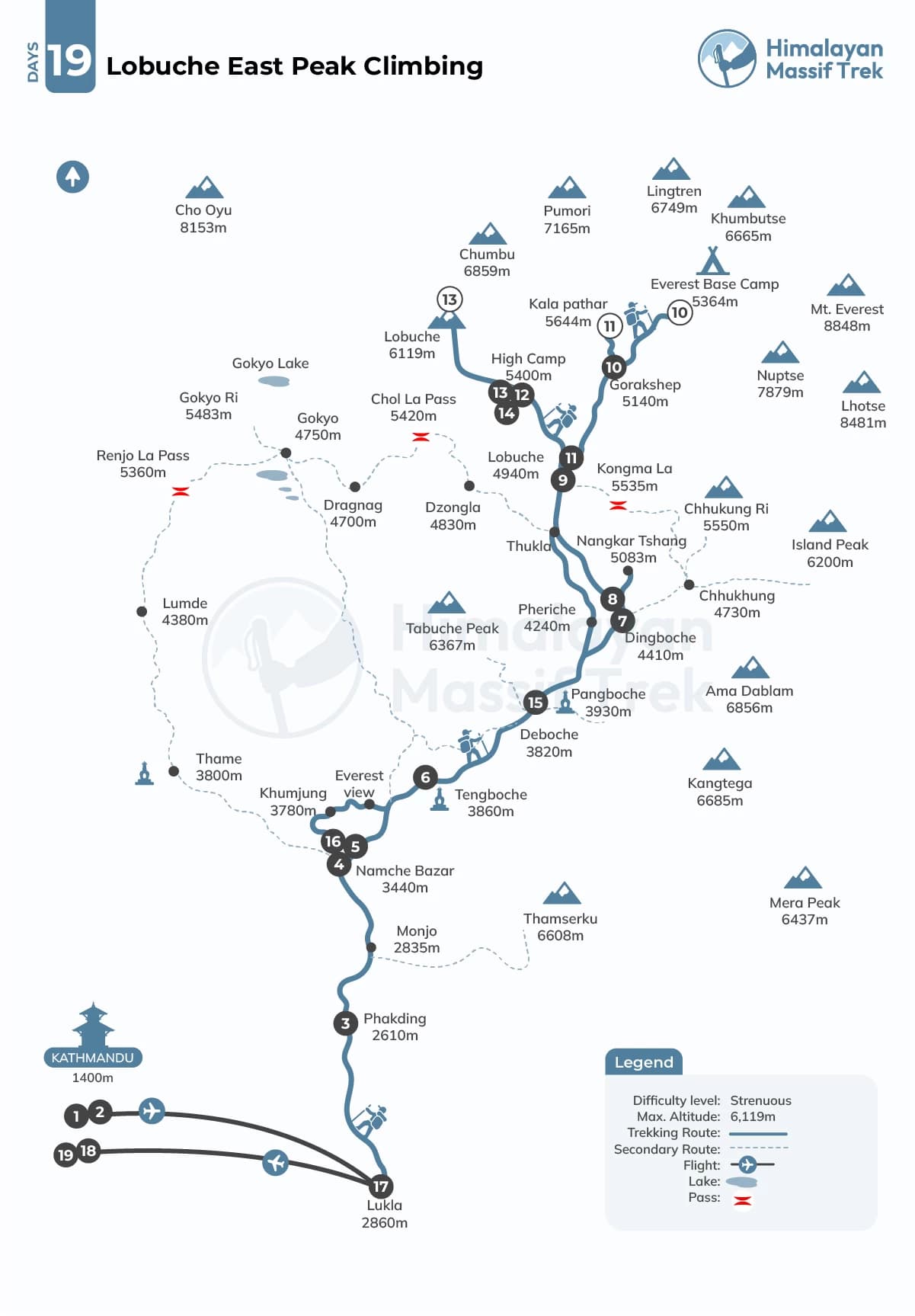

Cost Details
Transport and flights:
- Airport pick up and drop
- All ground and domestic air transfers for the trip
- Domestic flight to Lukla and return to Kathmandu ( Flights will operate from Ramcehhap during April, May, October and November)
Accommodation:
- 3-Star Accommodation in Kathmandu for 3 nights
- Teahouse Accommodation during the trek
- Tented camps accommodation during the climbing
Meals:
- 3-Standard meals each day
- Set of Breakfast, Lunch, and Dinner
Pemit:
- Climbing permits, trekking permits, National park permits
Guide and porters:
- Certified and qualified English-speaking trekking/
- climbing guide (with a supporting crew of assistants and porters)
- One porter between two climbers
Equipment:
- Duffel Bag, Down Jacket, Sleeping Bag, Tent, Ropes and Harness
- First Aid kit
Miscellaneous:
- Compensation, meals, accommodation, and insurance for the guide and supporting crew
- Communication equipment, and medical evacuation coordination
- 24-hour administrative and online support to monitor the trip conditions, prepare for emergencies, and contact insurance companies
- Nepal Visa Fee
- International Airfare
- Lunch and Dinner in Kathmandu
- Rescue & travel insurance, trip cancellation costs, accident or health emergency, evacuation, loss, theft, or damage to baggage
- Extra night accommodation in Kathmandu due to any reason
- Personal expenses (phone calls, internet, laundry, bar bills, battery recharge, extra porters, cold drinks, bottled or boiled water, hot shower, etc.)
- All alcoholic and non-alcoholic beverages
- Tipping for Guides and Porters
- Personal clothing and other climbing gear not mentioned in the includes section
To confirm your payment, a deposit payment is required, which is 30% of the total booking price. This deposit helps us secure permits, logistics, and other necessary arrangements for your trek.
We understand that plans can change, and we strive to be as flexible as possible. However, to cover operational costs, a cancellation fee applies. This is a percentage of your total booking price and is deducted from the deposit payment.
Cancellation Fees
Cancel 30% days before departure: 5% of the trip cost
Cancel between 10 to 30 days before departure: 10% of the trip cost
Cancel within 10 days of departure: 20% of the trip cost
If you need to cancel, please notify us as early as possible to reduce charges.
Rescheduling
Unexpected circumstances can disrupt travel plans, even if you still want to do the trip. To support our clients, we have generously waived all rescheduling fees. You can postpone and reschedule your trip at no additional cost, as long as the new departure date falls within one year of your original booking.
Upgrades
If you wish to upgrade your accommodation, transportation, or any other services not mentioned in the Trip Includes section, please be aware that these upgrades will incur additional costs. We can assist in arranging these options for you based on your preferences and availability.
Lukla Flights
Non-Refundable Flight Ticket: If you need helicopter evacuation or other means of transport due to altitude sickness or any other condition, your return flight ticket fare is non-refundable.
Refundable Flight Ticket: If the flight operator cancels your flight due to bad weather in Lukla, Kathmandu, or any other reason, your flight ticket fare is 100% refundable.
Dates & Availability
Private TripIf you don't find an appropriate date, you can propose a Preferred Departure Date, and we’ll ensure the trip runs as scheduled just for you.
Trip Gallery
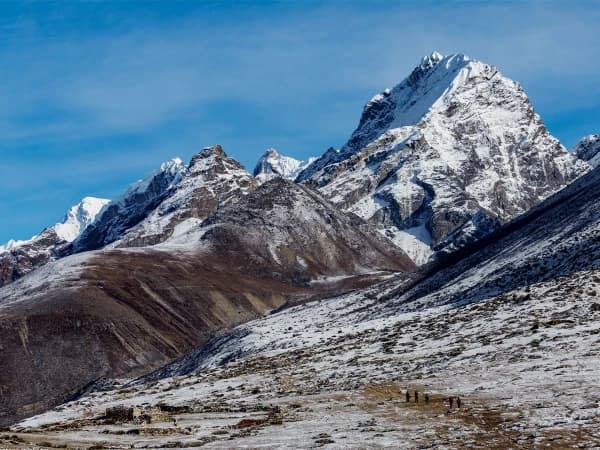
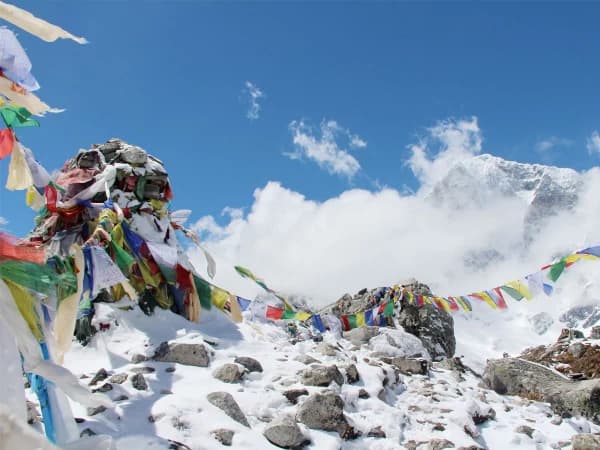

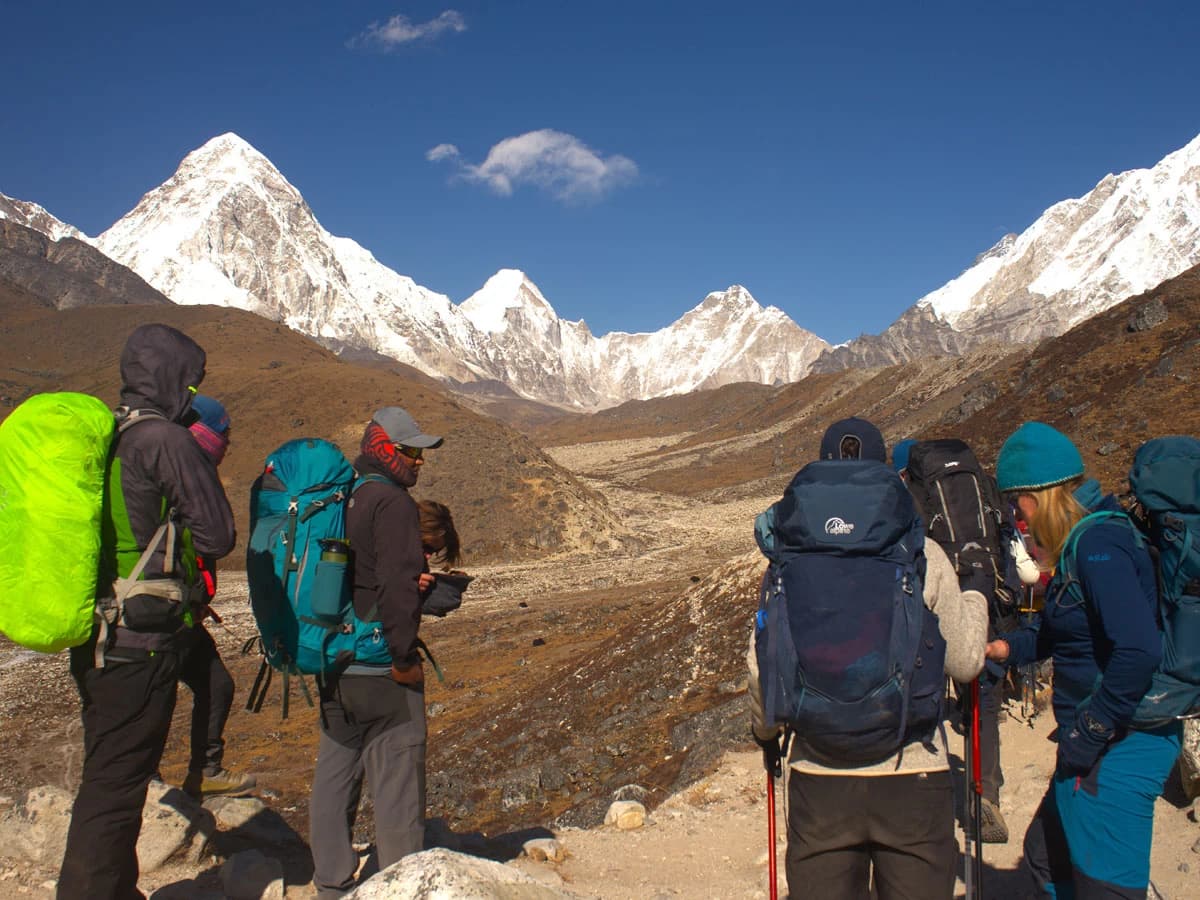
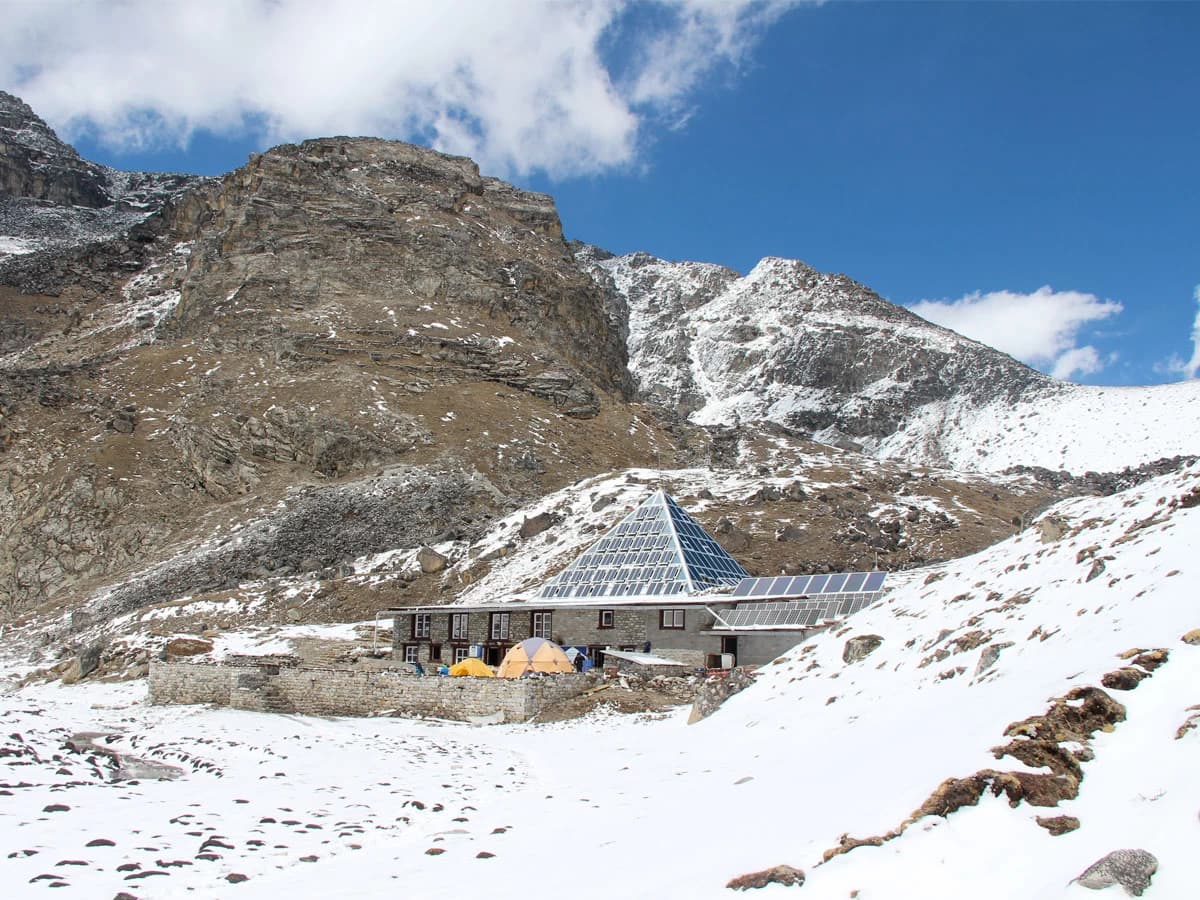
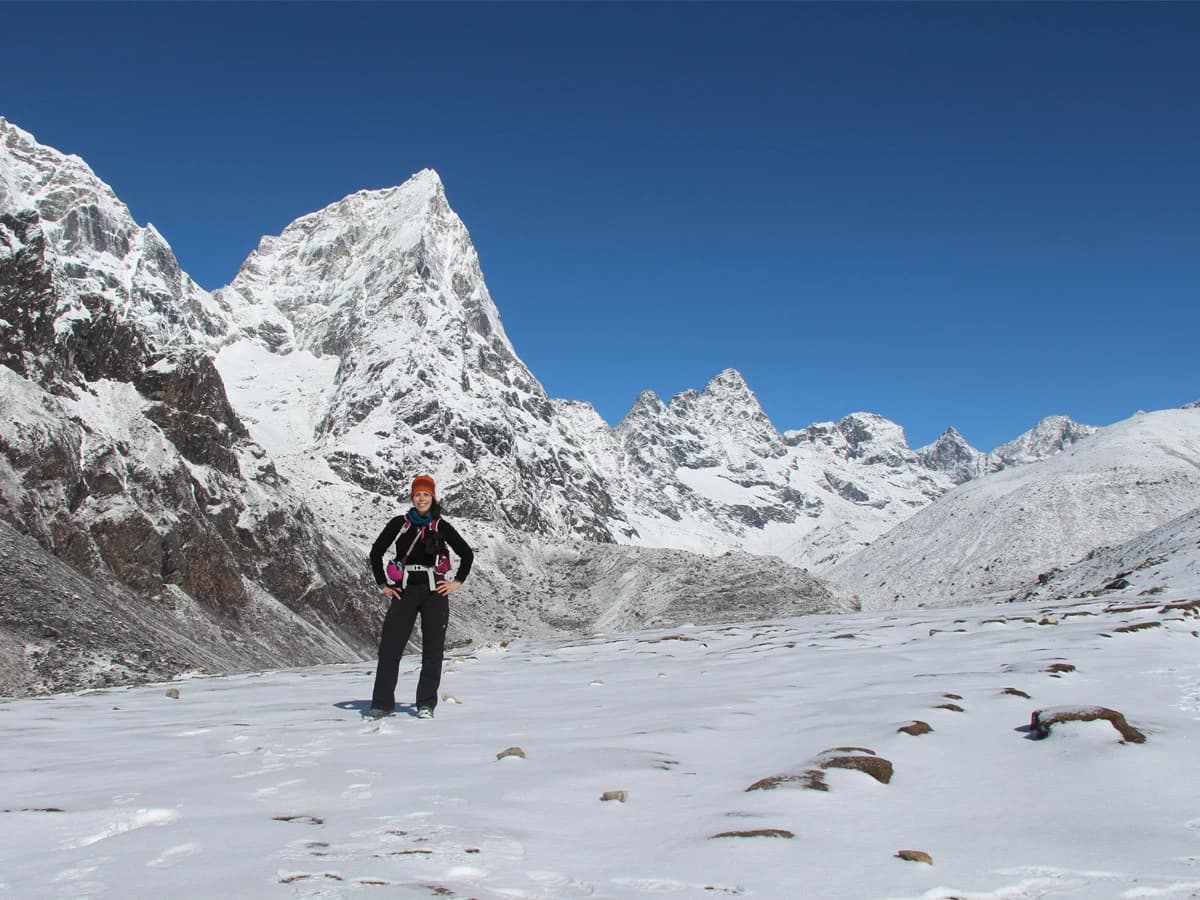
Essential Information
Physical and Technical Training for Lobuche Peak Climb
Cardiovascular Endurance Training: Engage in activities such as hiking, running, cycling, and stair climbing to improve stamina for long trekking days. These exercises help strengthen the lungs and heart, ensuring better oxygen circulation at high altitudes. Interval training with bursts of high-intensity effort followed by short recovery periods is particularly effective in building endurance.
Strength Training: Focus on developing muscle strength in key areas, including legs, core, and upper body. Exercises like squats, lunges, deadlifts, and step-ups will improve leg power for steep ascents and descents.
Core exercises such as planks and Russian twists enhance stability, crucial for maintaining balance on uneven terrain. Upper body training, including pull-ups and shoulder presses, will help with rope climbing and carrying a loaded backpack.
Weighted Hikes: Simulate real trekking conditions by hiking with a weighted backpack. Gradually increase the weight over time to build muscle endurance and prepare for carrying gear during the climb. This practice also improves posture and walking mechanics, reducing the risk of injury on steep and rugged trails.
Mental Preparation: Climbing Lobuche Peak requires mental resilience to push through exhaustion, cold temperatures, and challenging terrain. Developing mental toughness through long endurance workouts, meditation, and visualization techniques can help trekkers stay focused and determined during the ascent.
A well-structured training plan incorporating these elements will significantly improve fitness, technical ability, and confidence, ensuring a safer and more successful Lobuche Peak summit experience.
If possible, climbers should take a basic mountaineering course or practice on smaller peaks before attempting Lobuche. Altitude training, such as trekking at high elevations or using hypoxic masks, can help the body adapt to reduced oxygen levels.
With the right preparation, trekkers can confidently face the challenges of Lobuche Peak and maximize their chances of reaching the summit safely.
Travel Insurance for Lobuche Peak Climbing
Having comprehensive travel insurance is a must for any trekker attempting Lobuche Peak. The extreme altitude and technical nature of the climb require coverage that includes emergency medical evacuation, trip delays, and unforeseen cancellations. Ensure that your policy specifically covers mountaineering and trekking at altitudes up to 6,000 meters, as Lobuche Peak sits at an elevation of 6,119 meters (20,075 feet).
Helicopter Evacuation Coverage
In the event of altitude sickness or a serious injury, a quick evacuation by helicopter may be necessary. This type of coverage can be a lifesaver, as the region’s medical facilities are limited and can be hours away by foot. Having the assurance that evacuation will be handled promptly can give you peace of mind during the climb.
Trip Cancellations and Delays
Flights to Lukla are often delayed or canceled due to the unpredictable weather conditions in the Everest region. This can lead to potential disruptions to your schedule. Your insurance should cover these unexpected delays, including trip cancellations due to weather or unforeseen circumstances like illness or injury, ensuring you’re not left financially exposed.
Baggage and Gear Coverage
Lobuche East Technical Climb requires specialized trekking and climbing gear, which can be expensive. Your insurance policy should cover the loss, damage, or theft of your gear, whether it occurs during your flight, at the airport, or while trekking. This ensures that if something happens to your equipment, you’re not left with unexpected costs.
Policies for Different Nationalities
Depending on your country of residence, various travel insurance providers cater specifically to trekkers heading to high-altitude areas like Lobuche Peak. For example:
Australian trekkers can benefit from policies like World Nomads or Cover-More, which offer coverage for high-altitude trekking and include emergency evacuation, trip cancellations, and baggage loss.
US trekkers may consider Allianz Global Assistance or Travel Guard, which offers similar policies that cover trekking, high-altitude activities, and emergency medical evacuation.
UK trekkers can explore options such as InsureandGo or Smith & Sons, which provide insurance tailored for trekking at high altitudes, including emergency medical care and helicopter evacuation.
Canadian trekkers can look to Manulife or TuGo, which offer coverage for high-altitude trekking, including evacuation and medical treatment.
European trekkers can turn to Europäische Reiseversicherung or AXA Assistance, which provide insurance policies that meet the requirements for trekking in high-altitude regions up to 6,000 meters.
Altitude And Acclimatization Tips for Lobuche East Peak Climbing
Altitude plays a critical role in the Lobuche East Peak Climb, influencing everything from physical performance to overall safety. As climbers ascend beyond 3,000m (9,800ft), the air becomes thinner, reducing oxygen levels and increasing the risk of Acute Mountain Sickness (AMS). Given that Lobuche East stands at 6,119m (20,075ft), proper acclimatization is not just beneficial, it is essential for a safe and successful summit attempt.
Acclimatization allows the body to gradually adapt to the reduced oxygen levels, helping to prevent serious altitude-related illnesses such as AMS, HACE (High Altitude Cerebral Edema), and HAPE (High Altitude Pulmonary Edema). A well-planned itinerary includes gradual altitude gain, strategic rest days, and overnight stays at higher elevations before the summit push.
A highly effective way to acclimatize while making the most of the journey is the “climb high, sleep low” approach. In the Lobuche Peak Climb, this is achieved by trekking to Everest Base Camp (5,364m) and Gorak Shep (5,140m), followed by a hike to Kala Patthar (5,644m).
This segment of the Lobuche East Climbing and EBC Trek exposes climbers to higher altitudes and thinner air, helping the body gradually adapt before returning to Lobuche (4,940m) for rest. Not only does this provide a natural and effective way to adjust to high-altitude conditions, but it also offers an opportunity to explore some of the most iconic locations in the Everest region. The breathtaking sunrise over Everest from Kala Patthar is a highlight of the journey, adding awe-inspiring moments alongside essential acclimatization.
While it may be tempting to opt for a shorter itinerary to save time and money, skipping proper acclimatization significantly increases the risk of altitude sickness and can make the climb far more challenging. A rushed ascent leaves little time for the body to adapt, and symptoms of AMS such as headaches, nausea, dizziness, and fatigue—can escalate quickly, forcing climbers to descend prematurely or, in severe cases, requiring emergency evacuation.
A responsible approach to acclimatization ensures that climbers not only reach the summit but also enjoy the journey in a safer, more comfortable manner. Strategies such as staying hydrated, maintaining proper nutrition, pacing the ascent, and listening to the body’s signals are all crucial for a successful climb.
Lobuche East Peak Climbing Equipment List
FAQs
Start the summit push around 1-2 AM to reach the top before mid-morning when winds pick up and altitude sickness risks increase.
Acclimatization is crucial for adjusting to the reduced oxygen levels at higher altitudes. Trekking at a gradual pace, with strategic rest days, allows the body to adapt and reduces the risk of altitude sickness.
Even short hikes feel harder at high altitudes due to lower oxygen availability. On the Trekking to Everest and Summitting Lobuche East Trip, trekkers often experience breathlessness and muscle fatigue.
At high altitudes, sleep can be disrupted due to lower oxygen levels, causing frequent awakenings or shortness of breath. During the Trek to Everest and Summit Lobuche East, trekkers may experience lighter sleep or vivid dreams.
In terms of drinks, trekkers are provided with hot tea, coffee, and hot chocolate to keep warm. Boiled water is provided for hydration, and trekkers are encouraged to drink plenty to stay hydrated at high altitudes.
In the higher regions, especially near Lobuche Base Camp and High Camp, the food options tend to focus on high-energy, easily digestible meals. Common offerings include dal Bhat, noodles, vegetable curry, and pasta.
In the lower regions, local Sherpa families often serve meals and manage teahouses. In higher regions, cooks employed by the trekking companies prepare meals.
In the lower regions of the trek, trekkers typically stay in teahouses or lodges. These provide basic comforts, such as shared rooms, hot meals, and access to communal areas for socializing.
Trekkers typically spend around 3-4 nights at high camps during the Lobuche East Climb. This includes 1-2 nights at Lobuche Base Camp (4,950m) for acclimatization and preparation, followed by 1-2 nights at High Camp (5,400m) before the final summit attempt.
Trekking to Lobuche East alone is not permitted, as a guide is compulsory for the safety of climbers. In Lobuche Peak climbing, the trek is done in a group to ensure that all participants have the necessary support and guidance.
Trekkers often find the cultural experience of the Lobuche East climb to be one of the most enriching aspects of the journey. As you pass through Sherpa villages, interact with locals, and explore Buddhist monasteries, you'll get a sense of the deep-rooted traditions and values of the mountain communities.
The local Sherpas have immense respect for trekkers who challenge themselves with climbs like Lobuche East, as it demonstrates both determination and a deep appreciation for the Himalayas.
The final summit push for Lobuche East starts at 1-2 AM to ensure climbers reach the top before the weather conditions become unfavorable. Early starts allow trekkers to take advantage of colder, more stable weather.
Besides altitude, sleep deprivation before summit day, bitter cold (-20°C or lower), and the mental challenge of pushing through exhaustion are often underestimated.
It typically takes 2 days to reach the Lobuche East Summit after reaching High Camp. Summit day (Day 13) is the longest, lasting 8-10 hours. The total duration of the trek is about 16 days.
It is not advisable to attempt Lobuche East Peak climbing during the monsoon season (June to August), as heavy rainfall can make the trails slippery and increase the risk of landslides and avalanches.
The chances of summiting Lobuche East in bad weather are significantly reduced to zero. Poor visibility, high winds, and heavy snow can make the climb dangerous, and Himalayan Massif Trek prioritizes safety above all else.
Winds that can exceed 40-50 km/h (25-30 mph) are common, and gusts can be even stronger, particularly during the afternoon. These winds can make the conditions feel much colder and more challenging.
Lobuche Peak is more technical than Island Peak, with steeper ice climbing, a more exposed summit, and a harder final ascent.
To be environmentally responsible during your climb, it’s essential to follow Leave No Trace principles. This means packing out all trash, using biodegradable soaps, and avoiding the use of plastic where possible by opting for reusable water bottles and gear.
Expertly Crafted Adventure by Seasoned Professionals
At Himalayan Massif Trek, we don’t just take you to the summit of Lobuche East (6,119m)—we prepare you for success every step of the way. With years of experience in high-altitude mountaineering, our expert guides ensure a seamless and safe ascent, precisely navigating the steep ridges, icy slopes, and technical sections. We design our itinerary with acclimatization and training in mind, allowing you to adapt gradually while taking in the breathtaking Everest region. At Lobuche High Camp, our seasoned climbers provide hands-on training in rope techniques, glacier travel, and ice climbing, ensuring you are confident before the summit push.
Years of Experience in Himalayan Expeditions
Over the years, we’ve developed a unique approach to mountaineering, going beyond the basics to ensure that every expedition is successful and a memorable, life-changing experience. Our extensive experience goes far beyond organizing climbs; we have crafted the art of navigating the rugged terrains, unpredictable weather, and tricky climbing conditions that define peaks like Lobuche East.
Authorized and Certified Trekking Specialists
At Himalayan Massif Trek, we pride ourselves on being fully authorized and certified by the government and the Nepal Tourism Board, ensuring that your trekking experience is not only thrilling but also safe and professionally managed. Our team of highly skilled climbing guides and trekking specialists undergo rigorous training and certification to guarantee that they are equipped with the knowledge and expertise to navigate the rugged terrains of the Himalayas. They are licensed to operate in all regions of Nepal, ensuring that every climber or trekker enjoys the highest standards of safety and service.
Trusted by Adventurers Worldwide
Himalayan Massif Trek has earned the unwavering trust of adventurers from around the globe, not just through promises, but through consistent success in guiding climbers to the summits of some of the most challenging peaks, including Lobuche East. With hundreds of climbers who have successfully completed their expeditions under our expert guidance, our reputation is built on proven results, client satisfaction, and word-of-mouth endorsements from those who have experienced exceptional service firsthand.
- Expertise in High-Altitude Trekking Adventures
- Over 18 Years of Experience in The Himalayas
- Authorized and Reliable Trekking Partner
- Trusted by Thousands of Adventurers Worldwide

I’ve climbed in the Rockies, the Alps, and even Kilimanjaro, but Lobuche East was something else entirely. The climb was tough, no doubt, but our...
I trained hard for this, but nothing quite prepares you for the thin air at 6,000m. The acclimatization plan was solid, and our guides made...
